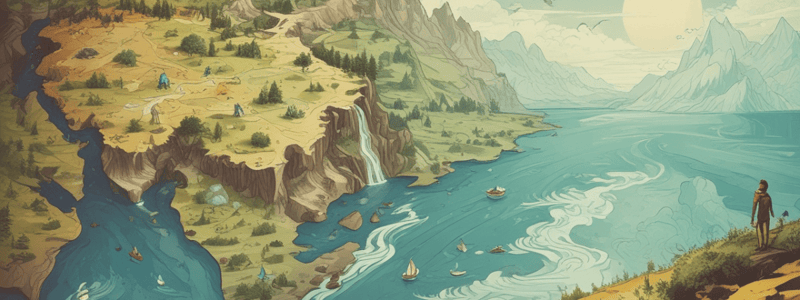Podcast
Questions and Answers
What is the significance of water in the growth of cities?
What is the significance of water in the growth of cities?
- It provides a source of energy
- It provides land for housing
- It provides fertile floodplain land for farming, ways to transport goods for trade, and freshwater for drinking (correct)
- It provides a means of recreation
Which mountain range is the longest in the United States?
Which mountain range is the longest in the United States?
- The Rocky Mountains (correct)
- The Appalachian Mountains
- The Sierra Nevada mountains
- The Cascades
What is the name of the largest mountain in the contiguous United States?
What is the name of the largest mountain in the contiguous United States?
- Mount Denali
- Mount McKinley
- Mount Rainier
- Mount Whitney (correct)
What is the name of the hottest and driest place in the United States?
What is the name of the hottest and driest place in the United States?
What is the longest river in the United States?
What is the longest river in the United States?
What is the largest drainage system of all U.S rivers?
What is the largest drainage system of all U.S rivers?
What percentage of the world's fresh water do the Great Lakes contain?
What percentage of the world's fresh water do the Great Lakes contain?
What is the deepest lake in the United States?
What is the deepest lake in the United States?
What is the main focus of physical maps?
What is the main focus of physical maps?
What is the primary distinction between physical and human characteristics?
What is the primary distinction between physical and human characteristics?
What is a common feature of many large cities in the United States?
What is a common feature of many large cities in the United States?
What is the population of the Washington, DC metro area?
What is the population of the Washington, DC metro area?
What is an example of a human characteristic in the United States?
What is an example of a human characteristic in the United States?
Which of the following is NOT a physical characteristic?
Which of the following is NOT a physical characteristic?
What is the population of the city of Los Angeles?
What is the population of the city of Los Angeles?
Flashcards are hidden until you start studying
Study Notes
Physical Characteristics
- Physical characteristics are natural features of the land, including landforms, rivers, coasts, bays, mountains, canyons, valleys, and lakes.
- The United States has a rugged terrain with many mountains, including the Rocky Mountains, Appalachian Mountains, Cascades, Alaska Range, and Sierra Nevada mountains.
- The largest mountain in the United States is Mount McKinley in Alaska, while the largest mountain in the contiguous United States is Mount Whitney in California.
- Notable valleys and canyons include Death Valley, the Grand Canyon, and Napa Valley.
- Rivers and lakes are crucial for human life, providing drinking water, water for farming, and fertile land.
- The Missouri and Mississippi Rivers are the largest and most important rivers in the U.S., with the Missouri being the longest river at 2,341 miles.
- Other notable rivers include the Rio Grande, the Colorado River, and the Yukon.
- The United States has the Great Lakes in the Northeast, which contain 21% of the world's fresh water, as well as the Great Salt Lake in Utah and Crater Lake.
Human Characteristics
- Human characteristics are features of a geographical area caused by humans, including cities, towns, dams, roads, and communication links.
- The largest cities in the United States are New York, Los Angeles, Chicago, Houston, and Philadelphia, with many of these cities located near bodies of water.
- River cities include New York, New Orleans, Washington, DC, and Philadelphia, while coastal cities include Los Angeles, New York, San Diego, and San Francisco.
- Water is important for population growth, as it provides fertile land, transportation, and drinking water.
- Other major U.S. cities include Phoenix, San Antonio, San Diego, and Dallas.
Studying That Suits You
Use AI to generate personalized quizzes and flashcards to suit your learning preferences.




